Raymond III, sometimes numbered Raymond II (died in or about 1008), was the count of Rouergue and Quercy from 961 to his death. Raymond achieved a suzerainty over several neighbouring counties and successfully titled himself margrave of Septimania (Latin marchio, or even dux, duke). He was the son and successor of Raymond II.
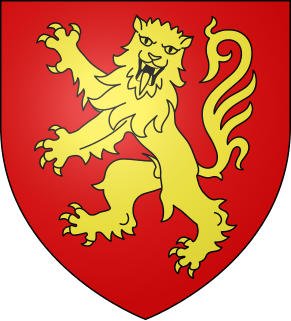
This is a list of the counts of Rouergue.

Quercy is a former province of France located in the country's southwest, bounded on the north by Limousin, on the west by Périgord and Agenais, on the south by Gascony and Languedoc, and on the east by Rouergue and Auvergne.
Raymond II, sometimes numbered Raymond I was the count of Rouergue and Quercy from 937 to his death. He was the son of Ermengol of Rouergue and Adelaide. Under Raymond, Rouergue achieved a suzerainty over neighbouring counties and he successfully titled himself Margrave (marchio) of Septimania.
According to the Liber miraculorum Sancte Fidis (Book of the Miracles of Saint Faith), Raymond died while on a pilgrimage to Jerusalem. Prior to his departure, he gave the Abbey Church of Saint Foy twenty-one gilt silver vessels, an expensive gilt saddle and an estate on the Mediterranean coast with its saltworks. According to the Liber, he acquired the saddle as booty in a war against the Saracens. [1] This probably refers to his participation in a defensive campaign against the Córdoban general al-Mansur prior to 987. [2]

Jerusalem is a city in the Middle East, located on a plateau in the Judaean Mountains between the Mediterranean and the Dead Sea. It is one of the oldest cities in the world, and is considered holy to the three major Abrahamic religions—Judaism, Christianity, and Islam. Both Israel and the Palestinian Authority claim Jerusalem as their capital, as Israel maintains its primary governmental institutions there and the State of Palestine ultimately foresees it as its seat of power; however, neither claim is widely recognized internationally.

The Abbey Church of Saint Foy St. in Conques, France, was a popular stop for pilgrims traveling the Way of St. James to Santiago de Compostela, in what is now Spain. The main draw for medieval pilgrims at Conques were the remains of St. Foy, a young woman martyred during the fourth century. The relics of St. Foy arrived in Conques through theft in 866. After unsuccessful attempts to acquire the relics of St. Vincent of Saragossa and then the relics of St. Vincent Pompejac in Agen, the abbey authorities set their sights on the relics of St. Foy at the ancient St. Faith's Church, Sélestat. The Conques abbey opened a priory next to the shrine in Sélestat. A monk from Conques posed as a loyal monk in Agen for nearly a decade in order to get close enough to the relics to steal them.
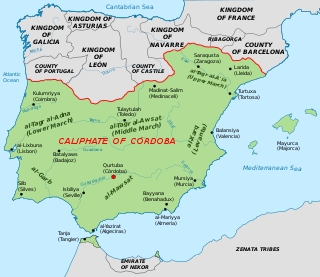
The Caliphate of Córdoba was a state in Islamic Iberia along with a part of North Africa ruled by the Umayyad dynasty. The state, with the capital in Córdoba, existed from 929 to 1031. The region was formerly dominated by the Umayyad Emirate of Córdoba (756–929). The period was characterized by an expansion of trade and culture, and saw the construction of masterpieces of al-Andalus architecture. In January 929, Abd ar-Rahman III proclaimed himself Caliph of Córdoba, replacing thus his original title of Emir of Córdoba. He was a member of the Umayyad dynasty, which had held the title of Emir of Córdoba since 756.
By his death, Raymond was suzerain over Albi and Nîmes and his son received 50,000 solidi or one half of the total payment for the archbishopric of Narbonne in 1016. On his death, his son Hugh received Rouergue, but the margraviate passed to William III of Toulouse.

Albi is a commune in southern France. It is the prefecture of the Tarn department, on the river Tarn, 85 km northeast of Toulouse. Its inhabitants are called Albigensians. It is the seat of the Archbishop of Albi. The episcopal city, around the Cathedral Sainte-Cécile, was added to the UNESCO list of World Heritage Sites in 2010.

Nîmes is a city in the Occitanie region of southern France. It is the capital of the Gard department. Nîmes is located between the Mediterranean Sea and the Cévennes mountains. The estimated population of Nîmes is 151,001 (2016).
Hugh was the Count of Rouergue and Gévaudan from 1008 to his death. He was the son and successor of Raymond II and he inherited suzerainty over neighbouring counties and over Narbonne.
This page is based on this
Wikipedia article Text is available under the
CC BY-SA 4.0 license; additional terms may apply.
Images, videos and audio are available under their respective licenses.
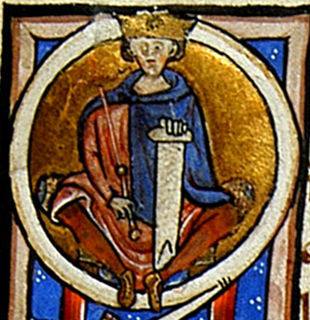
Alfonso Jordan (1103–1148) was the Count of Tripoli (1105–09), Count of Rouergue (1109–48) and Count of Toulouse, Margrave of Provence and Duke of Narbonne.

Pope Telesphorus was the Bishop of Rome from c. 126 to his death c. 137, during the reigns of Roman Emperors Hadrian and Antoninus Pius. He was of Greek ancestry and born in Terranova da Sibari, Calabria, Italy.
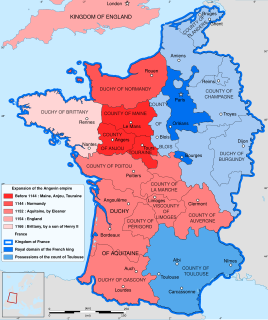
The Duke of Aquitaine was the ruler of the ancient region of Aquitaine under the supremacy of Frankish, English, and later French kings.

Rudolph or Rudolf was the elected King of France from 923 until his death in 936. Prior to his election as king, he was Duke of Burgundy and Count of Troyes from 921. He was the son of Richard, Duke of Burgundy, and Adelaide of Auxerre, and inherited the Duchy of Burgundy from his father. He married Emma of France, daughter of king Robert I of France. He is frequently confused with his uncle Rudolph I of Burgundy.

The Count of Toulouse was the ruler of Toulouse during the 8th to 13th centuries. Originating as vassals of the Frankish kings,
the hereditary counts ruled the city of Toulouse and its surrounding county from the late 9th century until 1270. The counts and other family members were also at various times counts of Quercy, Rouergue, Albi, and Nîmes, and sometimes margraves of Septimania and Provence.
Count Raymond IV founded the Crusader state of Tripoli, and his descendants were also counts there.
They reached the zenith of their power during the 11th and 12th centuries, but after the Albigensian Crusade the county fell to the kingdom of France, nominally in 1229 and de facto in 1271.
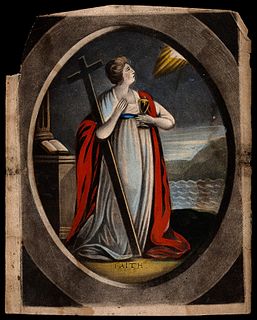
Saint Faith or Saint Faith of Conques is a saint who is said to have been a girl or young woman of Agen in Aquitaine. Her legend recounts how she was arrested during persecution of Christians by the Roman Empire and refused to make pagan sacrifices even under torture. Saint Faith was tortured to death with a red-hot brazier. Her death is sometimes said to have occurred in the year 287 or 290, sometimes in the large-scale persecution under Diocletian beginning in 303. She is listed as Sainte Foy, "Virgin and Martyr", in the martyrologies.

Wifred or Wilfred was the Count of Cerdanya and Count of Berga. He was the eldest son of Oliba Cabreta and Ermengard of Empúries.
William III Taillefer was the Count of Toulouse, Albi, and Quercy from 972 or 978 to his death. He was the first of the Toulousain branch of his family to bear the title marchio, which he inherited (c.975) from Raymond II of Rouergue.
Raymond Pons, who may be numbered Raymond III or Pons I, was the Count of Toulouse from 924.

The Roman Catholic Diocese of Rodez (–Vabres) is a diocese of the Latin Rite of the Roman Catholic Church in France. The Episcopal seat is in Rodez. The diocese corresponds exactly to the Department of Aveyron.
Fredelo, Fridolo, or Frigidolo was the first Count of Toulouse (844–852) of the dynasty of Rouergue.
Raymond I was the Count of Limoges, Rouergue and Quercy, and Toulouse and Albi. He was the younger son of Fulcoald of Rouergue and Senegund, niece of William of Gellone through his sister Alda.
Ermengol (870-937) was a son of Odo of Toulouse and Garsindis. His father gave him the County of Rouergue and Quercy in 906 and he governed it to his death. His brother was Raymond II of Toulouse and together they governed the vast patrimony of their house in the first half of the tenth century.
Raymond II was the Count of Toulouse, Nîmes, and Albi. He was the, probably elder, son of Odo of Toulouse and Garsenda.
Raymond III is the designation assigned to distinct or possibly-distinct Counts of Toulouse in the mid-to-late 10th century. Recent scholarship has overturned the traditional account of the counts during this period without consensus arising for a new reconstruction.

The County of Rodez was a fief of the County of Toulouse formed out of part of the old County of Rouergue in what is today Aveyron, France. Its capital was Rodez. At its height, it was a centre of troubadour culture.

The House of Toulouse, sometimes called House of Saint-Gilles, is the name of the dynasty that ruled the County of Toulouse.
Aimery I of Narbonne, son of Bernard Berenger of Narbonne and Foy of Rouergue. He was viscount of Narbonne 1071 until his death in the Holy Land in 1106.















